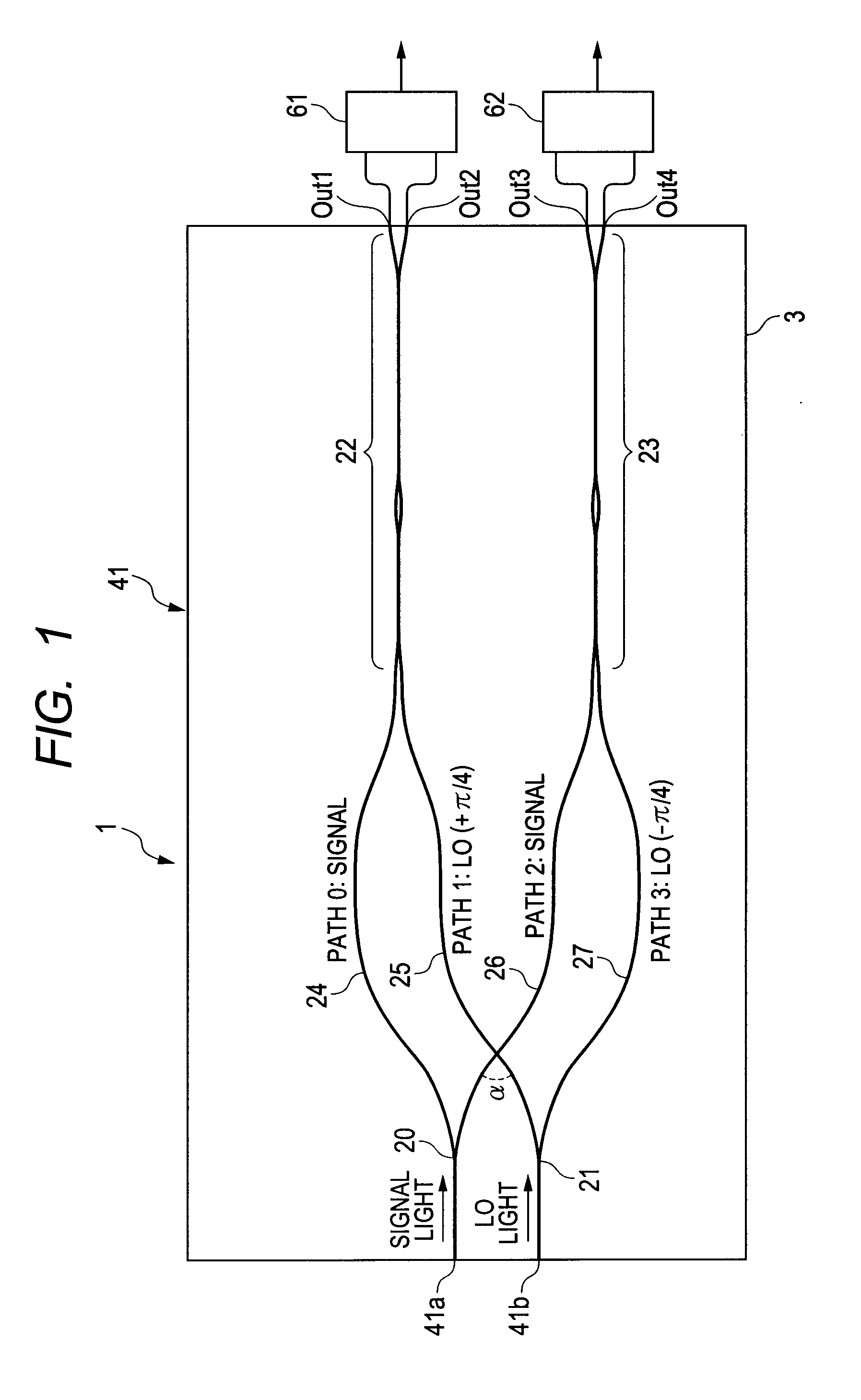90-degree hybrid
a hybrid and 90-degree technology, applied in the field of 90-degree hybrids, can solve the problems of instability of the operation of the 90-degree hybrid, the difference between the propagation loss and the the inability to achieve the propagation loss and phase characteristic of the two signal lights to be output, etc., to achieve stable operation and wide band
- Summary
- Abstract
- Description
- Claims
- Application Information
AI Technical Summary
Benefits of technology
Problems solved by technology
Method used
Image
Examples
first embodiment
[0039]A PLC-type 90-degree hybrid 1 according to a first embodiment is described based on FIG. 1 to FIG. 3. The PLC-type 90-degree hybrid 1 comprises: as illustrated in FIG. 1, a PLC chip 3 having a planar lightwave circuit formed therein; and a 90-degree hybrid circuit 41 which is formed in the planar lightwave circuit, and which mixes a modulated signal light and an local oscillation light to separate the signal light into quadrature components I and Q and output the same.
[0040]The 90-degree hybrid circuit 41 includes: two Y-branch couplers 20, 21 which are input side couplers; two wavelength-independent directional couplers (WINC) 22, 23 which are output side couplers; and arm waveguides 24 to 27 connected between the Y-branch couplers 20, 21 and the WINCs 22, 23. Note that, in the following description, the arm waveguides 24 to 27 may be referred to as a path 0 to a path 3, respectively.
[0041]As described above, the 90-degree hybrid circuit 41 includes: two Y-branch couplers 20,...
second embodiment
[0071]Next, a PLC-type 90-degree hybrid 1A according to a second embodiment is described based on FIG. 4.
[0072]In the PLC-type 90-degree hybrid 1A, as illustrated in FIG. 4, two 90-degree hybrid circuits 41, 42 with the same configuration are provided as the 90-degree hybrid circuit. The 90-degree hybrid circuit 41 is formed on the right upper side of a PLC chip 3 of rectangular shape close to substantially square, and the 90-degree hybrid circuit 42 is formed on the right lower side of the PLC chip 3, respectively.
[0073]There are three input ports In1, In2, and In3 on an input end 4. An X-polarization QPSK signal (DP-QPSK signal (X): X signal) incident upon the input port In1 enters the Y-branch coupler 20 of the 90-degree hybrid circuit 41 via an X-signal waveguide 36. Moreover, a Y-polarization QPSK signal (DP-QPSK signal (Y): Y signal) incident upon the input port In2 enters the Y-branch coupler 20 of the 90-degree hybrid circuit 42 via a Y-signal waveguide 37.
[0074]Moreover, an...
third embodiment
[0092]Next, a PLC-type 90-degree hybrid 1B according to a third embodiment is described based on FIG. 5.
[0093]In the PLC-type 90-degree hybrid 1B, as illustrated in FIG. 5, a plurality of input ports (four input ports In1 to In4, in the embodiment) is intensively arranged in the center of the input end 4.
[0094]Moreover, four output ports Out1 to Out4 of the 90-degree hybrid circuit 41 and four output ports Out5 to Out8 of the 90-degree hybrid circuit 42 are intensively arranged in the center of the output end 5.
[0095]The input ports In1, In2 are connected to the Y-branch couplers 21, 20 of the 90-degree hybrid circuit 41 via input waveguides 51, 52, respectively. Moreover, the input ports In3, 4 are connected to the Y-branch couplers 20, 21 of the 90-degree hybrid circuit 42 via input waveguide 53, 54, respectively. An LO light having the same wavelength and polarization as the X polarization DP-QPSK signal enters the input port In1, and the X polarization DP-QPSK signal (X signal) ...
PUM
 Login to View More
Login to View More Abstract
Description
Claims
Application Information
 Login to View More
Login to View More - R&D
- Intellectual Property
- Life Sciences
- Materials
- Tech Scout
- Unparalleled Data Quality
- Higher Quality Content
- 60% Fewer Hallucinations
Browse by: Latest US Patents, China's latest patents, Technical Efficacy Thesaurus, Application Domain, Technology Topic, Popular Technical Reports.
© 2025 PatSnap. All rights reserved.Legal|Privacy policy|Modern Slavery Act Transparency Statement|Sitemap|About US| Contact US: help@patsnap.com



